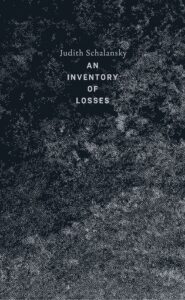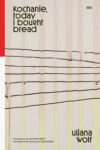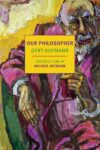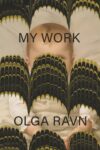
[New Directions; 2020]
Tr. from the German by Jacki Smith
It snowed last night and when I went on a walk this morning I saw something I’ve never seen before: a dense strip of thick white fog rising above a field covered with snow against a bluish sky. It only lasted a few minutes, and while the phenomena evaporated, I thought of the seemingly impenetrable persistence of those milky windows that Judith Schalansky describes in the first essay of An Inventory of Losses, called “Tuanaki”:
I studied those pictures, which still conveyed a sense of the longing that had inspired them, in a stuffy room in the cartography department, whose milky windows, as I discovered on inquiry, could not be opened as the pictures had to be protected.
An Inventory of Losses starts out with a two page list of cultural artifacts that disappeared and were discovered while the author was working on the book, and it is followed by a preface that guides us from an actual place associated with death, a North German village cemetery, into a meditation on decaying, forgetting, recounting, and remembering, which happens in a world filled with ruins, data storage, time capsules, playback devices, churches, temples, intellectual heredity, archives, maps, and biological heritage.
The two introductions are followed by twelve entries. Each one skillfully balances the “loss” — of ancient poetry, extinct tigers, ungraspable monsters, vanished filmstrips, sunken islands, or lost trust — against the “gain” of information, speculation, and knowledge about that which has been lost, and each one is written in a different tone and style. In some of them you can hear the writer, in others the child, the hoarder, the lover, the academic, the researcher, the local, the intellectual, the scientist, the historian, the botanist. Each entry is sixteen pages long, and like hand-picked samples in petri dishes, the growing cultures appear to be initially alienated from each other within the laboratory conditions of loss. What eventually unites them though, is their discipline to maintain a productive obsession. It feels, as if each of the twelve entries emits a sense of formal loyalty, a sort of reliable and occasionally rather predictable adherence to a writing style; each one as different from the other, as the subjects of the entries themselves: Tuanaki, Caspian Tiger, Guericke’s Unicorn, Villa Sacchetti, The Boy in Blue, The Love Songs of Sappho, The Von Behr Palace, The Seven Books of Mani, Greifswald Harbor, Encyclopedia in the Wood, Palace of the Republic and Kinau’s Selenographs.
An inventory is often described as a list of things and when one considers that the word list may have some origins in the German word Leiste, which is a wooden strip, a certain rigidity of this form of accountability feels almost natural. In “Behrenhoff, The Von Behr Palace,” for example, in which the narrator recounts some of her earliest childhood memories of growing up in a small village in Mecklenburg-Vorpommern in what was then the German Democratic Republic, she writes:
My mother’s ancestors were farmers, livestock and timber traders, carters and master butchers, a forester, a pointsman, a sailor. My father’s ancestors, my biological father, that is, were millers and master tailors, cartwrights and carpenters, a musketeer, a few doctors, a seamstress of fine fabrics, a fisherman, a railway guard, a chemist, an architect, a factory owner, an armaments manufacturer, who after the war became a cemetery gardener.
The chronology indicates that the narrator comes from a lineage of humans defined by their professions, professions in turn all come with certain skills and vocabularies and therefore most likely with specialized ways of describing the world. It made me wonder if that built-in heritage inspired the author to write the twelve entries in such different styles.
An Inventory of Losses also made me wonder about the two letters “re” and their implications. I asked myself: What is the difference between a discovery and a rediscovery, what makes searching different from researching? I think the answer lies somewhere between knowledge and faith. Judith Schalansky’s writing very much depends on archives, libraries and existing knowledge, it doesn’t vaguely stumble into the unexpected, it knows what it is looking for. If the writing is faithful, then it’s faithful to the power of knowing, knowing that nothing will ever be lost, knowing that new technologies and ancient archives will always enable new rediscoveries, which in some cases will lead to a recoveries. Another “re.”
In one of the entries, “Guericke’s Unicorn,”the narrator spends a few weeks in a chalet in a deserted Alpine hamlet to write a guide on monsters,
those beasts that, despite having sprung mostly from human imagination, still, as I once had blithely asserted when pitching this book project, in spite of all denials of their existence, populated the world just as surely as all the varieties of real-life fauna, meaning that, as I suggested to the group of potential financial backers, it was possible not only to research but also to categorize their nature, their physical features, their ancestral habitats and individual behavior.
In order to write the proposed guide, the narrator had packed a huge number of books and carried them into the chalet where she studies and categorizes the phenomena in self-imposed isolation from other humans until her research begins to disappoint her. She cannot get to the mystery that, according to the books, comes with monsters. Eventually she takes a break from her research and with a heightened sense of awareness for her surroundings, ventures down into the village where she wants to spend time among people. She enters a shop, there are shelves, there is a shopkeeper and a costumer.
The shopkeeper called out something to the man. I did not understand a single word. And no matter how hard I tried, I would never understand any of it.
She leaves the shop an on her way back to the chalet she notices that the tattooed unicorn, which she had spotted on the cashier’s inner wrist, has a strong impact on her. She makes her way through the forest in fear and eventually physical pain, she becomes scared of things in the woods and in herself. The next day she meets a man in the otherwise deserted Alpine village. He talks to her in an animated fashion,
and unusually fast for that dialect. It seemed to be about something important. I told him that I could not understand what he was saying. He repeated his litany, just as rapidly as before, until I shook my head again. He had blackish-brown, deep-set eyes protected by bushy brows. He looked at me, then at my boots and walked on without any gesture of regret or apology.
Human gestures, facial expression, body language, a dialect, the sound of a voice, spoken words, deep set eyes, bushy brows — that nothing of those things could be understood by the same narrator who a few days earlier had learned “that the griffin originated from Hyperborea or India and the enormous roc from Arabia, that Chinese dragons possessed five, Korean four, and Japanese three toes, that basilisks liked to live in damp well-shafts, and that the thorny tentacles of the South American flesh-eating plant, the Ya-te-veo, caused fatal ulcers,” and who had “agonized over whether the scarlet Mongolian death worm, olgoi-khorkhoi, belonged with the cryptids, a group in any case only loosely defined, or alternatively with the snakelike beings . . . ” made me realize that An Inventory of Losses is most of all about the loss of the spontaneity, the unpredictability, the pleasure and the humor that comes with random real life human contact and (mis)communication.
A question from the shopkeeper, a hurried shake of the head from me, and again the shame that, whenever anyone here addressed me, I could never understand a word.
Are books teachers, or companions? Can anything about humans be understood in isolation from other living humans? Do humans ever want to understand anything but themselves? Can one be understood by oneself? Would such an understanding bring any joy, meaning and satisfaction? Or do these feelings only come with being understood by others, do those things rely on human recognition?
The hermit in the entry “Encyclopedia in the Wood” talks about his dream of self-sufficiency, and even though he speaks in thermo-technical terms, when he says that “Books make an excellent insulating material” for rooms during cold weather, I connected this observation to the stack of books about monsters in the chalet and wondered how they may have insulated the researching narrator in “Guericke’s Unicorn” from engaging with the spoken language of the village people.
Judith Schalansky writes in the preface to her book:
Writing cannot bring anything back, but it can enable everything to be experienced. Hence this volume is as much about seeking as it is about finding, as much about losing as gaining, and gives a sense that the difference between presence and absence is perhaps marginal, as long as there is memory.
I do not share this confidence in writing, in reading, or in memory. While my brain is somewhat trained to comprehend the idea that the difference between presence and absence is marginal as a theoretical abstract, my body always carries the helpless intensity of fearing loss, which includes the loss of words. When loss strikes it happens in real time, incredibly fast or painfully slow over years and years and years, and when it is happening there is no rationality to cushion the free fall. There are no memories or explanations yet to stuff the growing holes that keep sucking with an otherworldly force. Loss is so powerful not only because of the things lost. It is so cruel and all-consuming because it turns us completely loose, it expels us from the knowable world and shoots us out of the universe, it turns us into radicals.
To minimize that fear by writing from a standpoint that assumes that every loss, big or small, in every corner of the world and time in history can be eventually remembered and accounted for, struck me a few times as a dangerous and arrogant practice, especially when something in me or around me sensed that losing the fear of loss could ultimately be more destructive than all the recovered losses of the past combined. If there is evidence that everything lost, burnt, drowned and gone extinct can eventually be researched, rediscovered and recovered, don’t we lose the skill and courage to fight the unfathomably roaring monsters that gulp up part of our worlds? Does the faith in recovery make us lose respect for loss? Does recounting research deny our losses the power of being fundamental holes in the world?
Twelve times does An Inventory of Losses open and close a capsule, twelve times do we start and end an account, like we start a month on the first and end it 31 days later, until we have a year, which adds itself to a calendar whose linearity wraps itself around the globe at a zero degree latitude and provides a measurable sense of continuity. At the beginning of each entry, twelve photographs, printed with very dark black ink on black paper, stand there like burnt shadows and humanize the paper-thin granite walls, which contain the ungraspable fear to let go. You need to tilt and turn the beautifully bound hardcover book and cast some extra light onto these dark pages, only then will you see in those gatekeepers the contours of human faces, buildings, animals and mythological creatures. And after that, when you have read some of the more tightly packed entries, when you have done the work of the night, and the work of the past, you may open the window and add some air, fluff up the night’s head-heavy density, like Mother Hulda in a Grimm’s Fairy Tale likes her pillows to be shaken out in the morning — so that those feathers fly about like snowflakes.
Franziska Lamprecht is an artist who started writing as an extension of the long-term process based works, she produces together with her husband Hajoe Moderegger under the name eteam. Their projects have been featured at PS1 NY, MUMOK Vienna, Centre Pompidou Paris, Transmediale Berlin, Taiwan International Documentary Festival, New York Video Festival, International Film Festival Rotterdam, the 11th Biennale of Moving Images in Geneva, among many others.
This post may contain affiliate links.







